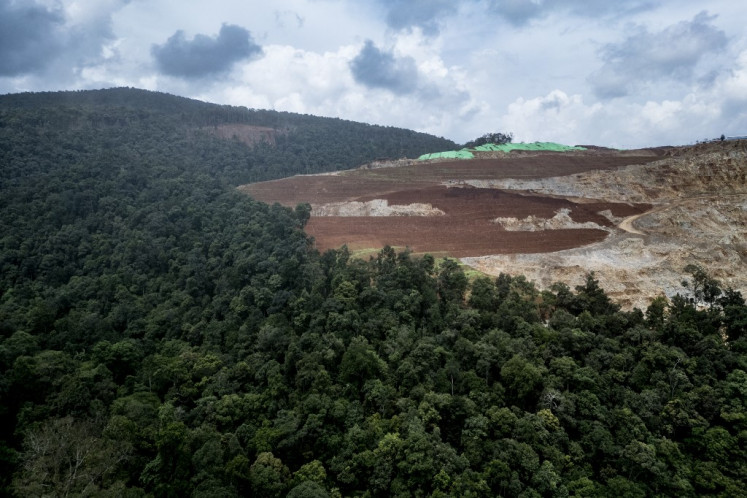Popular Reads
Top Results
Can't find what you're looking for?
View all search resultsPopular Reads
Top Results
Can't find what you're looking for?
View all search resultsChildren's question-answer blog books distributed nationwide
Many more answers to other youngsters’ questions have been provided by relevant specialists.
Change text size
Gift Premium Articles
to Anyone
Why are there seven days of the week? Do UFOs exist?
Have you ever thought about how to answer such questions? These are the types of questions that commonly come from children aged 10-12 from all over Indonesia, according to children’s question-answer blog
anakbertanya.com.
A professor of mathematics and physics at the Bandung Institute of Technology (ITB), Hendra Gunawan, initiated the blog, through which he invited experts from different backgrounds to provide answers.
“So far, there have been around 3,000 questions and most of them remain unanswered,” Hendra said.
The question pertaining to the seven-day week came from M. Hilmi, a 13-year-old from Mojokerto, East Java. Hendra used his knowledge as a mathematician to answer it.
Hendra said men used to observe the repetition of natural occurrences, beginning with the appearance of the full moon. Ancient Babylonians needed to mark their days to guide their daily activities.
The span of time from one full moon to the next, lasting 29 days, was seen as too long and was divided into four periods, each being equivalent to about
seven days.
“Since then, a week has been established as comprising seven days,” explained Hendra on the blog.
Several centuries later in ancient Greece, men identified the sun, moon and five other planets —Mercury, Venus, Mars, Jupiter and Saturn.
“They referred to the days with the names of Gods related to the seven sky objects. The first day was for the sun, the second the moon, the third Mars, the fourth Mercury, the fifth Jupiter, the sixth Venus and the seventh Saturn,” he added.
Regarding UFOs, Hendra asked the help of Avivah Yamani, an astronomer and founder of Langit Selatan, an astronomy media community.
Avivah described UFOs as unidentified objects appearing in the sky. As an example, she referred to people who had never seen aircraft before and that in their first sighting they may assume the planes to be UFOs from outer space carrying aliens.
“But UFO and alien sightings by most people have never been supported by solid evidence. Although there’s no proof yet, it doesn’t mean that humans are the only advanced living beings in the universe,” Avivah said.
The ITB graduate of astronomy also indicated that if any other life with highly sophisticated technology existed on a planet near another star, it would take a very long time to reach the earth.
“The star closest to the sun, Proxima Centauri, is 4.24 light years away. If any spacecraft travels at the speed of light of around 300,000 kilometers per second, it takes 4.24 years to arrive there, let alone the other stars,” added Avivah.
Many more answers to other youngsters’ questions have been provided by relevant specialists.
Every year, according to Hendra, the questions and their answers are published in book form by the Common Room Networks Foundation.
Six editions of Anak Bertanya Pakar (Children Ask the Experts) have been published, ranging from 98 to 160 pages, and two 32-page illustrated books, respectively, entitled Sudah Besar Mau Jadi Apa?’ (What Do You Aspire To Be When You Grow Up?) and Apakah UFO itu Ada?’ (Do UFOs exist?).
“They’re printed to be distributed to various regions in Indonesia because not all areas are accessible by the internet,” Hendra said.
The collection of children’s questions was inspired by the nationwide school curriculum in 2013.
Hendra and his ITB peer, G. Hadiyanto Nitihardjo, had originally sought ways to make children more interested in science.
“We began with children from eight SOS Kinderdorf [children’s village] units from Aceh to Papua. We gathered their questions and tried to find experts who could provide answers,” recalled Hendra.
With only 500-1,000 volumes printed in the beginning, the number swelled to 8,000 to become 480 packages by the end of 2017. Hendra attributed the book production hike to contributions from the social devotion fund of ITB as well as donations from PT Asuransi Jiwa Sequis Life, PT Asuransi Umum BCA, PT Asuransi Jiwa BCA, TUGU Group and PT Asuransi Samsung Tugu.
The books’ distribution is supported by Pustaka Bergerak Indonesia, a mobile library network with 764 literacy points throughout Indonesia, benefiting from the free book delivery program on the 17th of each month offered by PT Pos Indonesia.
“Each point receives one package with two sets of Anak Bertanya Pakar. Literacy points will deliver the books to children and communities. So, the books aren’t just kept at the library,” Nirwan Ahmad Arsuka, the library
founder, said.











